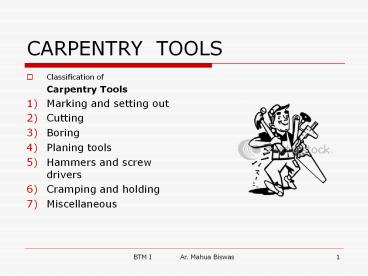CARPENTRY TOOLS - PowerPoint PPT Presentation
Title:
CARPENTRY TOOLS
Description:
CARPENTRY TOOLS Classification of Carpentry Tools Marking and setting out Cutting Boring Planing tools Hammers and screw drivers Cramping and holding – PowerPoint PPT presentation
Number of Views:11434
Avg rating:3.0/5.0
Title: CARPENTRY TOOLS
1
CARPENTRY TOOLS
- Classification of
- Carpentry Tools
- Marking and setting out
- Cutting
- Boring
- Planing tools
- Hammers and screw drivers
- Cramping and holding
- Miscellaneous
2
CARPENTRY TOOLS Marking and setting out
- Marking lines /points on wood
- Square To set right angles
- Bevel To set angles other than a right angles
- Marking gauge and mortise gauge For marking
lines parallel to the edges - Marking point and scribing knifeTo mark points
and lines on wood
3
Cutting tools
- Tool used for cutting wood - Compass saw
- Tools used for cutting timber members are -Coping
saw, Cross cut saw , Dovetail saw - Tools used for cutting and shaping joints are
Tenon Saw, Firmer Chisel, Mortise Chisel, Paring
Chisel
4
Boring
- Used for driving holes in timber members
- Rachet brace-cutting bit is attatched to its
lower end and the bit is rotataed with the help
of brace handle - Centre Bit, Auger Bit, Rose Counter Sunk Bit,
Screw Drive Bit Used for boring holes of
different size and shapes - Brad Awl ,Pointed Awl These have sharpened and
pointed ends wirth the help of which small and
fine holes can be made . - Gimlet It has screwed end with which small holes
can be bored - Auger Used for deep boring
5
Planing tools
- Used for Planing surface and for cutting small
mouldings along the edges - Bead plane
- Jack plane
- Rebate plane
6
Hammers and screw drivers
- Used for driving nails and screws and other
fastenings - Claw Hammer, Mallet Hammer, Spall Hammer,
Wallers Hammer. - Screw Driver, Ratchet Screw Driver
7
Miscellaneous
- Cramp For clamping timber ,to cut or make
groove. - Nail punch Making small hole before driving nail
so that timber does not split on surface - Oil stone Various tools and blades
- Pincers Pliers For taking out damaged nails
8
(No Transcript)
9
Fastenings
- Timber joints are secured in position with the
help of following commonly used fastenings - Wire nails
- Cut nails
- Floor brads
- Lath nails
- Treenail
- Pins
- Screws
- Coach screw
- Bolts
- Spikes
10
- Connecters
- Dig
- Dowels
- Sockets
- Straps
- Wedges
- Fasteners
11
Fixtures and fastenings
- Hinges
- Bolts
- Handles
- Locks
12
Hinges
- back flap hinge
- Butt hinge
- Counter flap hinge
- Garnet hinge
- Nar madi hinge
- Parliamnetry hinge
- Pin hinge
- Rising butt hinge
- Strap hinge
- Spring hinge
13
(No Transcript)
14
Latch
- Any wood or metal device that is attached to a
door or window to keep it closed - The latch consists of plain bar of wood or metal
which is attached to door or gate and is pivoted
so that it can be raised by hand above a hook or
keep attached to door or window frame. - These simple crude devices serve the purpose of
keeping the door or window in the closed position
15
Handle
16
Locks
- A lock is any device of wood or metal which is
attached to a door or window to keep it closed by
the operation of a bolt that moves horizontally
into a striking plate or staple fixed to door or
window frame - Most locks are made of steel or brass and combine
the operation of keeping doors and windows closed
with a latch bolt operated by handle or lever and
keeping doors and windows securely shut by the
operation of a loose key to move a lock bolt
17
(No Transcript)
18
Rat trap bond
- The rat trap bond (RTB) was first introduced by
eminent architect Laurie Baker in India and
supported by HUDCO. - In the RTB bricks are placed on edge in 16
cement mortar as shown in the picture. - With this technique there is reduction in cost
of the wall by 25 as with conventional English
bond (9thk wall) 350 bricks are required per
cu. m whereas in Rat-trap bond only 280 bricks
are required and also the reduced number of
joints reduces the mortar consumption. - No plastering of the outside face is required
and the wall usually is quite aesthetically
pleasing and the air gaps created within the wall
help make the house thermally comfortable.
19
Rat trap bond
- In summer the temperature inside the house is
usually atleast 5 degrees lower that the outside
ambient temperature and vice versa in winter. - Thus the main advantages of using Rat trap bond
are - Reduction in cost of the wall by 25.
- The reduction in number of joints, reduces
mortar. 25 less dead weight, 18 savings in
bricks and 54 savings in cement mortar - Thermally comfortable Aesthetically pleasing.































